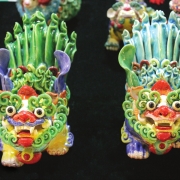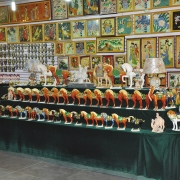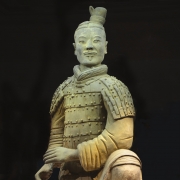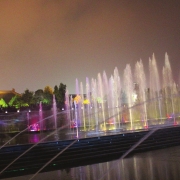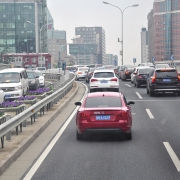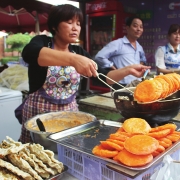
Etcetera
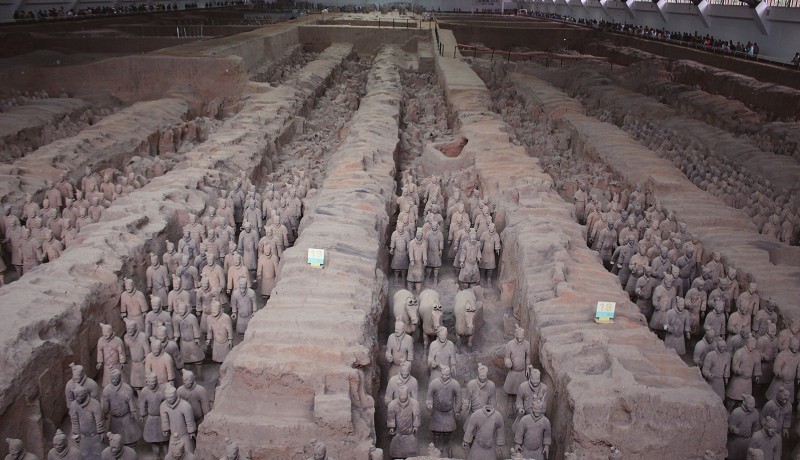
Xi’an, one of the oldest surviving cities, is not just home to clay warriors but a melting pot of past and present influences
We are two coach-loads, a little over three score of us, coincidentally mostly silvers, on a tour of China. The oldest among us is a quiet but cheerful septuagenarian who has endeared himself to the rest of us by his sheer demeanour and disposition. Following an inordinately delayed flight, thanks to the inclement weather at Shanghai through which we are routed to the Chinese capital, we arrive at the beautifully designed Beijing International Airport.
We hold our breath as our luxury bus skirts through an impeccably clean city that enjoys more than 3,000 years of history and was ruled by five major dynasties. A plethora of Sovietstyle monuments dot the ‘City of Ring Roads’, which is square-shaped and resembles the neck of a rooster. We make several leisurely halts at its various landmarks including Tiananmen Square, the Forbidden City, Summer Palace and, of course, its greatest wonder, The Great Wall, which runs 8,851 km.
It is evident as we walk around Beijing that the nation has invested hugely in the infrastructure and restoration of its heritage sites, perhaps in the wake of the Olympics in 2008. We thirst for more as we take the first flight out from Beijing to Xi’an, the next city in our itinerary. Under the expert stewardship of our tour manager Nihal and our local guide, the charming Lily Wang, we embark on sightseeing right away. We head to the city’s most impressive landmark, the monumental Terracotta Warriors Museum, aka the Tomb of Qin Shi Huang, to see the world’s coolest funeral art ever. Incidentally, the museum is listed by UNESCO as a world heritage site.
Dense, dark clouds dance on the horizon. A heavy downpour seems imminent as our coach weaves its way through broad avenues of trees, most of them laden with young pomegranates. The fruit, we learn, found its way into Xi’an from Persia through the Silk Route during the Han Dynasty.
The fountainhead of Chinese civilisation and one of the oldest surviving cities of the world, Xi’an was the starting point of the ancient Silk Road. China’s gateway to the West, Xi’an or Chang’an, as it was then known, is where the caravans would start off from and return to. A cultural hub, it not only served as the capital of 13 imperial dynasties including the Zhou, Qin, Han and Tang dynasties but was also one of the world’s greatest cities during the 8th century, with a significant population of foreigners. In fact, the city witnessed a new lease of life during the Ming Dynasty, which included its name change to Xi’an, meaning ‘western peace’.
On our way to the Terracotta Warrior Museum, we halt at the terracotta factory, which focuses on replicating soldiers, besides exhibiting other clay, crystal inner painting and lacquer artefacts and wall murals. The expansive boulevard leading to the museum from the parking bay is awash with colour as vendors beckon visitors to buy their wares. Flanking its sides are stalls that groan under juicy persimmons, luscious pomegranates, big red jujubes and other fruits. The aroma from frying snacks and steaming dumplings tickle our nostrils and set our palettes salivating. While on the subject of food, the spicy cuisine of Xi’an is predominantly made from wheat and vinegar unlike the rest of China where soy and white sugar are extensively used. Wei, the Yellow River’s largest tributary, irrigates the agricultural lands of Xi’an, making for good wheat crops, the mainstay of its people.
We enter the huge museum only to be held spellbound by an awe-inspiring platoon of life-size earthenware soldiers, arranged according to their heights, proportionately rising with their ranks, commanders and generals being the tallest. The museum, spread over 14,000 sq m, is divided into three pits, which together contain over 8,000 military men, 130 chariots and 700 horses. However, only a fraction of the finds are on display. History records them as being buried with China’s first emperor, Qin Shi Huang Di, who sought to secure his afterlife in building this underground palace. Its excavations, the 20th century’s most significant, came about after its chance discovery in 1974 by farmers who were digging the region.
The clay warriors represent unparalleled sculptural achievement in the history of ancient China, with tremendous attention to minute details. No two figures are alike—in expression, attire or hairstyle. The soldiers have been carved in several postures: standing infantry, kneeling archers, wielding weapons, on horseback and chariots. Research points to the statues having been fired at high temperatures ranging between 9500 and 1,1000 Celsius, making them really hard. The exhibition hall of the bronze chariots contains the world’s largest and most intricate bronze relics.
Huang Di is credited with unifying large parts of China. He also began the construction of the Great Wall of China, standardised coins, weights and measures, linked the nation’s states with a network of roads and canals, and instituted the same writing system across all of China. The shrewd emperor was also ruthless and brutal in his treatment of the huge force that helped build his mausoleum. According to legend, 70,000 workers who laboured over the necropolis were buried within it to prevent disclosure of its details and location.
As evening sets in, Xi’an transforms into a maze of jewellery with its historic monuments embellished with neon lighting. We wind our first day’s tour of Xi’an with a visit to the White Goose Pagoda. En route, we catch glimpses of the brightly lit Bell Tower, a Tang dynasty structure, and symbol of Xi’an. According to legend, the edifice was built to clip the powers of a terrible dragon that brought a calamitous earthquake whenever it appeared. Its 6,500-kg bell is struck at dawn each day. In close proximity is the Drum Tower from which drums are sounded every sunset to signal the day’s end.
The 210-ft tall Wild Goose Pagoda in the heart of the city continues to stand out as an emblem of Buddhist monk Hieun Tsang’s epic journey from Nalanda. The 7th century monument, housing sutras and Buddhist figurines brought by Tsang, is a powerful symbol of China’s cultural and spiritual connection with India. We brave needle-sharp drizzles to visit the pagoda, against the backdrop of which is the illuminated musical fountain. We plonk ourselves at a vantage spot to watch the half-hour show and capture the beauty of the waltzing fountains, touted to be Asia’s largest.
We hit the bed to blissful slumber at Titan Central Park Hotel where we are booked. Located in Xi’an’s technology district, it is just 8 km from downtown and a 40-minute drive from Xi’an Xianyang International Airport.
Our second and final day in Xi’an is another wet day. We breeze through its major landmarks, most prominent among them being the 7th century City Wall, which divides the metropolis into the old and new city. Skyscrapers and office buildings with glass facades rub shoulders with the old city walls. The city is an interesting mix where the ancient and contemporary blend effortlessly, blurring the divide between the old and new cities. Our guide Lily Wang tells us that the local government is now moving in phases, residents from downtown or old city to the outer circle or new city in an effort to preserve the inner city as its heritage. It is claimed to be one of the largest ancient military defence systems in the world.
The heavenly showers that oscillate between drizzles and heavy blobs ruin our hopes of riding rented bicycles on top of the 14-m wide wall, which is 12-m high and runs around the city, covering a length of 14 km. Wang tells us September rains are routine, though mellow. This information does nothing to boost our sagging spirits as we miss strolling along the city’s alleyways and the maze of streets that form the Muslim Quarter, evidently the hub of Muslim community in the city. A veritable visitor’s haunt, this area is as old as the 7th century Tang dynasty and still carries the bustling cosmopolitan flavour of ancient times when foreigners settled by the droves, and were welcomed by the emperor. The many mosques here, which once rubbed shoulders with the king’s palace, bear testimony to Xi’an being a multicultural city. The alleyways of the Muslim Quarter pulsate with activity from lines of stalls vending a vast array of merchandise, from souvenirs to food. The area, a feast for the senses, boasts a whopping 700 and more halal sit-down restaurants and several more food stalls. Some of the specialties include the famed yangrou paomo—crumbled unleavened bread in mutton stew—fried rice with pickled Chinese cabbage and little capsicums, sticky rice and jujube cake, and the fruit pies made with persimmon relished as a distinct dessert in the region.
The impact of the Silk Route from ancient times is still discernible with a variety of spices and foods sold here that are distinctly different from those in other parts of China with some of the vendors tracing their roots to as far as Turkey and other regions of Central Asia. Food items apart, the streets of the Muslim Quarter are abuzz with peddlers selling souvenirs: wooden, marble and porcelain artefacts, chinaware, footwear, bags and clothes in motley colours.
Xi’an customs and cultures vary from those practised in rest of the country. Sons are a drain on financial resources, says Wang. We are surprised to hear that parents incur huge wedding expenses in getting their sons married as they are required to pay money to the bride’s family, apart from buying an apartment for their son!
We are treated to a boundless odyssey of nature’s play in Xi’an, as the sun and clouds share a comradeship in mystically delightful ways. Despite our disappointment at not being able to use our digital devices to capture the magnetic charm of Xi’an and savour the flavours of its little and large alleys thanks to the rains, we nevertheless enjoy nature in its myriad hues.
FACTFILE
BEST TIME TO VISIT
Sun, rain and clouds alternate in Xi’an for most of the year. The city has a temperate and continental monsoon climate with four distinct seasons: summer, spring, autumn and winter. Though an all-weather destination, Xi’an is at its best in spring and autumn. The annual Lintong Pomegranate Festival is held in September. It is also the best time to climb Mount Huashan, a popular tourist destination, to witness a spectacular sunrise. Trekkers need to carry gloves, a raincoat, walking stick, torchlight and first-aid kit.
OBTAINING A VISA
Xi’an has a 72-hour, visa-free transit policy for passengers from 51 countries or regions, when taking an international transfer via Xi’an Xianyang International Airport. Others visiting Xi’an need to obtain a Chinese visa before departure from their respective countries. For those who book group tours, the respective tour agency will obtain the visa, the fee for which is included in the tour cost.
GETTING THERE
There are multiple airlines from Delhi and Mumbai to Xi’an, including Air India, Jet Airways, China Southern Airlines, China Eastern Airlines, Cathay Pacific and Lufthansa. They all have one to three halts in between. As Xi’an is located in the heart of China, it takes no more than three hours to fly there from other major Chinese cities. Xi’an is also connected to other cities by high-speed bullet train.
ACCOMMODATION
Accommodation that suits all pockets is available. Prior booking needs to be made, especially for hotels in the urban area or near tourist locations, and during peak travel season.
SHOPPING
Miniature replicas of terracotta warriors made from clay as souvenirs, local handicrafts that include embroidery and paper cuttings, primitive paintings, embroidered cotton wall hangings and tote-bags. Bargaining is expected.
TIPS
Language and vegetarian food pose a major barrier. These and other unforeseen difficulties and hassles are best overcome by booking a tour with reputed travel companies. For those visiting Beijing who wish to see only the Terracotta Army Museum in Xi’an, you can do so in nine hours with a Beijing return flight and airport transport. The Terracotta Warriors Museum is open 365 days of the year from 8.30 am to 5.30 pm. The ticket price of RMB 150 (about ₹ 1,500) from 1 March to 30 November and RMB 120 (about ₹ 1,200) from 1 December to 28 February to the museum includes entry to watch the 15-minute movie on the terracotta warriors and entry to Qin Shihuang’s Mausoleum. While in the museum, don’t use flash photography. And be watchful of your wallets in and around the museum, as elsewhere in China.
Text & Photos: Chitra Ramaswamy Featured in Harmony — Celebrate Age Magazine March 2018
you may also like to read
-
Cracking the longevity code
Small yet impactful choices can be game-changers, writes Srirekha Pillai At 102, there’s no stopping Chandigarh-based Man Kaur, the world’s….
-
Home, not alone
While a regulatory framework is vital for senior-care facilities, the need of the hour is to develop an ecosystem to….
-
Birthday Girl
Published in a special edition to honour Japanese master storyteller Haruki Murakami’s 70th birthday, Birthday Girl (Penguin; Rs 100; 42….
-
A huge treat for music lovers
Published as the revised and updated second edition, Incomparable Sachin Dev Burman (Blue Pencil; Rs. 599; 470 pages) the authoritative….



